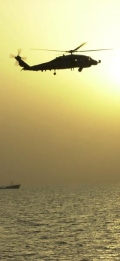|
AUGUST
2002

SH-60B
Seahawk from HSL-49's helo det aboard USS Vicksburg (CG 69)
patrols the Arabian Gulf. U.S. Navy photo by PM1 (SW) Arlo K.
Abrahamson.
|
| r u s s i a / f
s u |
in-stack 21 Aug 2002 |
"Russia's
Military and Operation Enduring Freedom"
Mikhail Tsypkin, Strategic Insight Feb/Mar 2002,
Center for Contemporary Conflict, Naval Postgraduate School
A short analytical piece on
U.S.-Russian cooperation in the war on terrorism, U.S. military presence in the
Central Asian "near abroad," and the reaction of the Russian armed
forces to U.S. successes in Afghanistan. Yet another specter of traumatic
change confronts the senior echelons of the Russian military.
| r u s s i a / f
s u |
in-stack 17 Aug 2002 |
"The
Mystery of the Hapless Varyag"
www.varyagworld.com
Compiled by Ahmet H. Demirayak, this
site tracks the mysterious fate of the former Soviet aircraft carrier Varyag,
the unfinished second hull of the Kuznetsov class of fixed-wing aircraft
carriers. Ostensibly purchased by a Chinese entertainment company for
conversion to a floating casino and entertainment center (much like Minsk),
observers have long suspected the involvement of the People's Liberation Army
Navy (which presumably would be interested in the Varyag as a study
hull). Today, no moves appear to have been made toward casino conversion,
and the hull itself is apparently moored at the PLAN naval base at Dalian.
Includes some very interesting
images of an engineless Varyag being towed through the Strait of Istanbul
last year (including some IKONOS satellite imagery).
| h o r i z o
n i s s u e s |
in-stack 9
Aug 2002 |
"The
Technology Secrets of Cocaine, Inc."
Business 2.0, July 2002
"How sophisticated is the
threat?" This fascinating article explores the remarkably robust,
frighteningly modern technical intelligence capabilities of the Cali cartel,
which included a counterintelligence data fusion center (centered around an
AS/400 mainframe) that was used to ferret out informants, systematic mapping of
the radar footprints of U.S. counterdrug surveillance flights, and a host of
fairly sophisticated communication security techniques. Naturally, all of
this capability is powered not by military computers but by commercial
off-the-shelf technologies.
| h o r i z o
n i s s u e s |
in-stack 9
Aug 2002 |
"Killing
Pablo: The Hunt for the World's Greatest Outlaw"
Mark Bowden (Penguin USA, paperback, Apr. 2002)
The story of the hunt for Pablo
Escobar, the notorious and flamboyant Medellin drug kingpin who forced the
Colombian government to its knees through intimidation, bribery, kidnapping,
torture, and an awful lot of very violent murders. Bowden (the talented
author of Black Hawk Down) tells a compelling and dramatic tale that
involves, among others, an incorruptible Colombian police colonel, American
diplomats and special operations personnel, a shadowy vigilante group with some
troubling ties to the police, and Pablo himself. Readers of this site may
find this book particularly worthwhile because of the attention that it pays to
technical intelligence methods; one of the American SOF units deployed to
Colombia was a military intelligence team operating under the name CENTRA SPIKE,
which Bowden describes as a detachment from the U.S. Army special operations
unit once known as the Intelligence Support Activity. These operators were
able to exploit vulnerabilities in Pablo's communications infrastructure,
despite some rudimentary COMSEC measures taken by the narcotraffickers.
After having read the Business
2.0 article referenced above, it's difficult not to conclude that the Cali
cartel -- which, according to Bowden, quietly worked hand-in-glove with the
Colombian government to eliminate their longtime Medellin rival -- learned some
valuable lessons about technical intelligence after Pablo's ultimate demise.
| r u s s i a / f
s u |
in-stack 9
Aug 2002 |
"The
Federal Border Guard Service"
Gordon Bennett, Conflict Studies Research Centre (Mar
2002) (PDF format)
A profile of the Federal Border
Guard Service (FPS) of the Russian Federation, functional successors to the USSR
KGB's border troops. The FPS has its own troop formations, aviation
element, and a small navy -- the latter of which has taken delivery of some
modern small combatants. Consistent with the CSRC's usual high quality of
reporting and analysis, Bennett includes details on recent policy controversies
involving the FPS and biographical sketches of its key leaders.
Back to Home Page || Contact
me |

